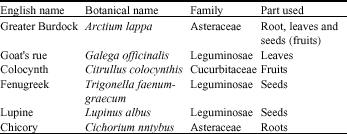Research Article
Biological Evaluation of Aqueous Herbal Extracts and Stirred Yoghurt Filtrate Mixture Against Alloxan-Induced Oxidative Stress and Diabetes in Rats
Department of Veterinary Medicine, Qassim University, Buraidah, Al-Qassim, Saudi Arabia
H.M. Mousa
Department of Food Science and Human Nutrition, College of Agriculture and Veterinary Medicine, Qassim University, Buraidah, Al-Qassim, Saudi Arabia
O.H. Omer
Department of Veterinary Medicine, Qassim University, Buraidah, Al-Qassim, Saudi Arabia
A.M. Abdel-Salam
Department of Food Science and Human Nutrition, College of Agriculture and Veterinary Medicine, Qassim University, Buraidah, Al-Qassim, Saudi Arabia












